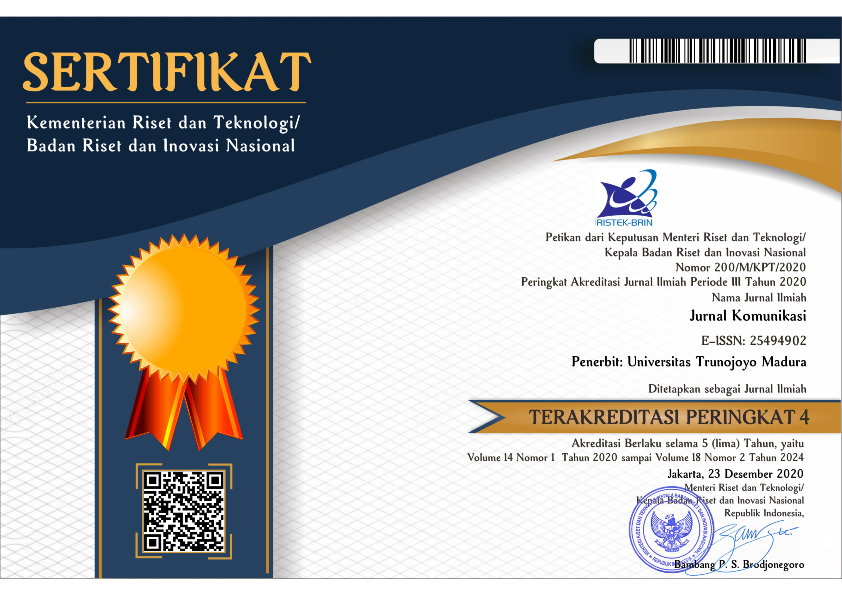Framing Analysis of Online Sexual Harassment News Against Online Motorcycle Bikes by Online Media Detik.com and Viva.co.id
Abstract
The issue of sexual harassment through online or online networking is a topic that is being seriously highlighted by various parties and comes to the fore in the term Online Gender-Based Violence (OGBV). This research focuses on the perspective of mass media reporting in bringing up a phenomenon of online sexual harassment to the public. Specifically, the study discusses the phenomenon of online sexual harassment cases that are actually experienced by men, namely Online Motorcycle Taxi (Ojol) drivers. This fact was analyzed textually using Robert Entman's model framing analysis method of two news manuscripts from two different online media, namely Viva.co.id and Detik.com. This research with a qualitative descriptive approach aims to find out the framing efforts and construction of reality made by the two online media around online sexual harassment cases against Ojol drivers through their respective news texts. The results of the study concluded that the two news stories on the online media had tried to insist on participation to the managers of the application service to provide protection to Ojol drivers which showed the partiality of the media to the victims. Based on the theory of media setting agendas, both news stories have included the agenda of the media and the agenda of the audience, but have not given a significant portion to the authorities as a policy agenda to come up with a solution to this problem of online sexual harassment
Keywords
Full Text:
PDFReferences
Arikunto, Suharsimi. (1996) Prosedur Penelitian. Jakarta: Rineka Cipta
Dedi. (2022, Juni 20). Viral!. Diduga Driver Ojol Jadi Korban Pelecehan Penumpang [Halaman Web]. Diakses dari https://www.viva.co.id/trending/1487224-viral-driver-ojol-diduga-korban-pelecehan-seksual-penumpang?page=1&utm_medium=page-1
Dewi, Ida Ayu Adnyaswari. (2019). Catcalling: Candaan, Pujian atau Pelecehan Seksual. Acta Comitas: Jurnal Hukum Kenotariatan, 4(2), 198-211.
Eriyanto. (2002). Analisis Framing Konstruksi, Ideologi, dan Politik Media. Yogyakarta: Lkis Group
Fadhilah, Annisa Nur et al. (2022). Pengalaman Pelecehan Seksual Laki-laki : Studi Fenomenologis pada Driver Online. Jurnal Diversita, 8(1), 22-31.
https://ojs.uma.ac.id/index.php/diversita/article/view/5017
Ghofur, A., & Rachma, E. A. (2019). Pemanfaatan Media Digital Terhadap Indeks Minat Baca Masyarakat Kabupaten Lamongan. Gulawentah : Jurnal Studi Sosial, 4(2), 85-92.
http://ejournal.unipma.ac.id/index.php/gulawentah/article/view/5524
Hamdani. (2011). Teori Agenda Setting: Teori Komunikasi Massa. Medan: Cita Pustaka Media Perintis
Handoyo, P. (2016). Representasi Perempuan dalam Media No Title. SEMINAR NASIONAL GENDER & BUDAYA MADURA III MADURA: PEREMPUAN, BUDAYA & PERUBAHAN, 137– 142
Hanitzcsh, Thomas. (2001). Teori Sistem Sosial dan Paradigma Kontruktivisme. E-Jurnal Unisba, (2)2, 217-229.
https://ejournal.unisba.ac.id/index.php/mediator/article/view/786
Hayati, Elli Nur. (2000). Panduan untuk Pendamping Korban Kekerasan. Yogyakarta: Rifka Anisa.
Holilah, Ilah. (2020). Dampak Media Terhadap Perilaku Masyarakat. Jurnal Studi Gender dan Anak, (7)1, 103-114. http://103.20.188.221/index.php/jsga/article/view/179
Indainanto, Y. I. (2020). Normalisasi Kekerasan Seksual Wanita di Media Online. Jurnal Komunikasi, 14(2), 104-118.
https://journal.trunojoyo.ac.id/komunikasi/article/view/6806
Israpil. (2017). Budaya Patriarki dan Kekerasan Terhadap Perempuan (Sejarah dan Perkembangannya). Jurnal Pusaka, 5(2), 141-150.
https://blamakassar.e-journal.id/pusaka/article/view/176
Komnas Perempuan. (2021). Lembar Fakta Catatan Tahunan (CATAHU) Komnas Perempuan Tahun 2020.
Kriyantono, R. (2010). Teknik Praktis Riset Komunikasi. Jakarta: Kencana.
Nuzuli, A. K., Natalia, W. K., & Adiyanto, W. (2021). Tinjauan Pelanggaran Kode Etik Jurnalistik dalam Pemberitaan Prostitusi Online di Surabaya. Jurnal Warta ISKI, 4(1), 35-43.
http://warta-iski.or.id/index.php/WartaISKI/article/view/108
Rossy, A. E., & Wahid, U. (2015). Analisis Isi Kekerasan Seksual Dalam Pemberitaan Media Online Detik.Com. Jurnal Komunikasi Untar, 7(2), 152-164. https://journal.untar.ac.id/index.php/komunikasi/article/view/15/36
SAFEnet. (2019). Memahami dan Menyikapi Kekerasan Berbasis Gender Online: Sebuah Panduan (Vol. 2).
Sayidah, Nur. (2018). Metodologi Penelitian : Dengan Contoh Penerapannya Dalam Penelitian. Sidoarjo : Zifatama Jawara
Sobur, Alex. (2012). Analisis Teks Media. Bandung: Rosdakarya.
Sugianto, Danang. (2022, Juni 20). Viral! Marak Driver Ojol Kena Pelecehan Oleh Penumpang [Halaman web]. Diakses dari https://finance.detik.com/berita-ekonomi-bisnis/d-6136258/viral-marak-driver-ojol-kena-pelecehan-seksual-oleh-penumpang
Thacker, L. K. (2017). Rape Culture, Victim Blaming, and the Role of Media in the Criminal Justice System. Kentucky Journal of Undergraduate Scholarship, 1(1), 89-99.
Vreese, Claes de. (2005). News Framing : Theory and Typology. Information Design Journal, University of Amsterdam, 13(1), 51-62 .
Wahyudiyono. (2019). Implikasi Penggunaan Internet Terhadap Partisipasi Sosial di Jawa Timur. Jurnal Komunika : Jurnal Komunikasi, Media Dan Informatika, 8(2), 63-68. https://jurnal.kominfo.go.id/index.php/komunika/article/view/2487/1168
DOI: https://doi.org/10.21107/ilkom.v17i1.16046
Refbacks
- There are currently no refbacks.
Copyright (c) 2023 Hanifan Ma'ruf

This work is licensed under a Creative Commons Attribution-ShareAlike 4.0 International License.
Jurnal Komunikasi by Universitas Trunojoyo Madura is licensed under a Creative Commons Attribution-ShareAlike 4.0 International License.















